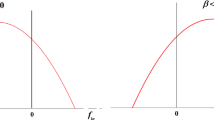Abstract
A recently developed algebraic approach to the feedback system design problem is reviewed via the derivation of the theory in the single-variate case. This allows the simple algebraic nature of the theory to be brought to the fore while simultaneously minimizing the complexities of the presentation. Rather than simply giving a single solution to the prescribed design problem we endeavor to give a complete parameterization of the set of compensators which meet specifications. Although this might at first seem to complicate our theory it, in fact, opens the way for a sequential approach to the design problem in which one parameterizes the subset of those compensators which meet the second specification...etc. Specific problems investigated include feedback system stabilization, the tracking and disturbance rejection problem, robust design, transfer function design, pole placement, simultaneous stabilization, and stable stabilization.
Similar content being viewed by others
References
Antsaklis, P. J., and J.B. Pearson, “Stabilization and Regulation in Linear Multivariate Systems”, IEEE Trans. on Auto. Cont., Vol. AC-23, pp. 928–930, (1978).
Barnett, S.Matrices in Control Theory, London, Van Nostrand, 1971.
Bengtsson, G., “Output Regulation and Internal Modes — A Frequency Domain Approach”, Automatica, Vol. 13, pp. 333–345, (1977).
Callier, F.M., and C.A. Desoer, “Stabilization, Tracking and Disturbance Rejection in Linear Multivariable Distributed Systems” Proc. of the 17th IEEE Conf. on Decision and Control, San Diego, Jan. 1979, pp. 513–514, (also Tech Memo UCB/ERL M78/83, Univ. of California at Berkeley, Dec. 1978).
Chang, L., and J.B. Pearson, “Frequency Domain Synthesis of Multivariable Linear Regulators”, IEEE Trans. on Auto. Cont., Vol. AC-23, pp. 3–15, (1978).
Cheng, L., and J.B. Pearson, “Synthesis of Linear Multivariable Regulators”, IEEE Trans. on Auto. Cont., (to appear).
Chua, O., M.S. Thesis, Texas Tech Univ., 1980.
Desoer, C.A., Liu, R.-w., Murray, J., and R. Saeks, “Feedback System Design: the fractional representation approach to analysis and synthesis”, IEEE Trans. on Auto. Cont., Vol. AC-25, pp. 399–412, (1980).
Feintuch, A., and R. Saeks,System Theory: A Hilbert Space Approach, New York, Academic Press, (to appear).
Francis, B., “The Multivariable Servomechanism Problem from the Input-Output Viewpoint”, IEEE Trans. on Auto. Cont., Vol. AC-22, pp. 322–328, (1977).
Francis, B., and M. Vidyasagar, “Algebraic and Topological Aspects of the Servo Problem for Lumped Linear Systems”, unpublished notes, Yale Univ., 1980.
Helton, J.W., ”Orbit Structure of the Moebius Transformation Semigroup Acting on H” inTopics in Functional Analysis, Advances in Mat. Supp. Studies, Vol. 3, New York, Academic Press, 1978, pp. 129–157.
Pernebo, L., Ph.D. Thesis, Lund Inst. of Tech., 1978.
Pernebo, L., “An Algebraic Theory for Design of Controllers for Linear Multivariable Systems; Parts I and II”, IEEE Trans. on Auto. Cont., (to appear).
Rosenbrock, H.H.,State-Space and Multivariable Theory, New York, J. Wiley and Sons, 1970.
Saeks, R., and J. Murray, “Feedback Systems Design: the tracking and disturbance rejection problems”, IEEE Trans. on Auto. Cont., Vol. AC-26, pp. 203–217, (1981).
Saeks, R., and J. Murray, “Fractional Representation, Algebraic Geometry, and the Simultaneous Stabilization Problem”, unpublished notes, Texas Tech Univ., 1980.
Viyasagar, M., Schneider, H., and B. Francis, “Algebraic and Topological Aspects of Feedback System Stabilization”, Tech Rpt. 80-90, Dept. of Elec. Engrg., Univ. of Waterloo, 1980.
Vidyasagar, M., and M. Viswanadham, “Algebraic Design Techniques for Reliable Stabilization”, Tech Rpt. 81-02, Dept. of Elec. Engrg., Univ. of Waterloo, 1980.
Wolovitch, W.A., “Multivariable System Synthesis with Step Disturbance Rejection”, IEEE Trans. on Auto. Cont., Vol. AC-19, pp. 127–130, (1974).
Wolovitch, W.A., and P. Ferreira, “Output Regulation and Tracking in Linear Multivariable Systems”, IEEE Trans. on Auto. Cont., Vol. AC-24, pp. 460–465, (1979).
Youla, D.C., “Interpolary Multichannel Spectral Estimation”, Unpublished Notes, Polytechnic Inst. of New York (1979).
Youla, D.C., Bongiorno, J.J., and H.A. Jabr, “Modern Wiener-Hopf Design of Optimal Controllers, Part I”, IEEE Trans. on Auto. Cont., Vol. AC-21, pp. 3–15, (1976).
Youla, D.C., Bongiorno, J.J., and H.A. Jabr, “Modern Wiener-Hopf Design of Optimal Controllers, Part II”, IEEE Trans. on Auto. Cont., Vol. AC-21, pp. 319–338, 1976.
Youla, D.C., Bongiorno, J.J., and C.N. Lu, “Single-Loop Feedback Stabilization of Linear Multivariable Dynamical Plants”, Automatica, Vol. 10, pp. 159–173, (1974).
Zames, G., “Feedback and Optimal Sensitivity: Model reference transformation, weighted seminorms, and approximate inverses”, IEEE Trans. on Auto. Cont., (to appear).
Author information
Authors and Affiliations
Additional information
This research was supported by the Joint Services Electronics Program at Texas Tech University under ONR Contract 76-C-1136.
Rights and permissions
About this article
Cite this article
Saeks, R., Murray, J., Chua, O. et al. Feedback system design: The single-variate case — Part I. Circuits Systems and Signal Process 1, 137–169 (1982). https://doi.org/10.1007/BF01600050
Received:
Revised:
Issue Date:
DOI: https://doi.org/10.1007/BF01600050




